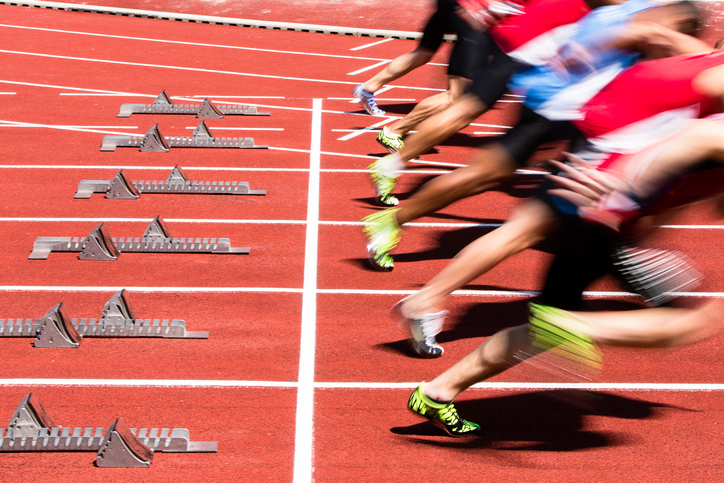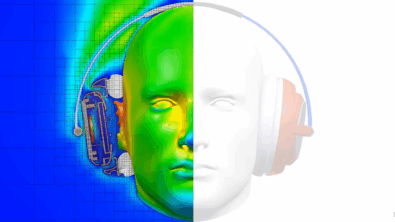Engineering Simulation at the Olympics

Originally conceived as a pure test of athletic ability, the motto of the Olympic games is “Citius, Altius, Fortius,” which is Latin for “Faster, Higher, Stronger.” However, Olympic competitors are increasingly supplementing hard work and training with engineering simulation in their quest for Olympic glory. As the sun sets over Rio and the Games of the XXXI Olympiad, I decided to investigate some of the ways engineering simulation is influencing the outcome of Olympic sporting events.
1. Cycling
Of all the sports, cycling is perhaps the one in which competitors are most concerned with pure aerodynamics. Drafting behind another cyclist reduces energy expenditure by around 20 percent compared with a cyclist who is not drafting. This is very apparent in the Team Pursuit discipline in which riders in a four-person team take turns to absorb the aerodynamic impact of the oncoming air for a while, before peeling off and cycling to the back of the rotating queue. Minimizing the aerodynamic drag of the bicycle and rider combination can be the difference between success and failure, between winning a gold medal or not making it to the medal stand, in a sport in which victory is often decided by hundredths of a second. At Rio 2016, Team GB took an almost clean sweep of track cycling medals using aerodynamically efficient Cervélo bicycles extensively designed using STAR-CCM+®. Other major bicycle manufacturers, such as Trek and component manufacturers such as FLO Cycling use a combination of STAR-CCM+ and HEEDS® to explore the entire design space before deciding on an optimal aerodynamic and structural design for their products. We also recently performed the first credible CFD simulation of a pedaling cyclist.
2. Balls
How difficult is it to design a spherical object? Apparently, more than you might think. Competitors expect that the balls in their sport will behave in an expected, predictable manner. During every World Cup, goalkeepers publicly complain about soccer balls that swerve and dip too much in the air (often leading to spectacular goals or ridiculous misses). Similarly, a golf ball that penetrates the air brilliantly but is prone to hook or slice is also unlikely to be popular with Olympic competitors or casual golfers. Most of the challenge with simulating balls is that their flight is determined by how surface features (such as stitching, laces, dimples and wear-and-tear induced roughness) alter the boundary layer as the ball spins, inducing transition on one side of the ball and not on the other. This requires the ability to resolve those surface details (usually involving very high computational cell counts) together with robust unsteady turbulence models that predict transition. STAR-CCM+ has variously been used for soccer balls, volleyballs, golf balls, shuttlecocks and even spiraling American footballs (not an Olympic sport but it looks a bit like a rugby ball).
3. Table Tennis
Perhaps my favorite Olympic CFD story of all comes from London 2012, for which Atkins used STAR-CCM+ to design a venue and ventilation system that wouldn’t disturb the flight of a ping pong ball. In their words: “Finessing the field of play, today’s table tennis professionals demand and expect the highest standards for the conditions in which international competition is played, and in the case of table tennis these are sophisticated. The reason is not hard to discern: a light, hollow, celluloid ball, measuring 40mm in diameter and weighing a mere 2.7g. If the merest puff of air can cause a ball to deviate, the background air velocity at a competition venue must be almost non-existent to ensure that it is only the players’ topspin or backspin that determines the ball’s flight path.”
4. Sailing
STAR-CCM+ has been used in the design of various Olympic sailing vessels, to analyze unsteady sail aerodynamics and to determine the optimum position of a sailor on an Olympic dinghy. When Sir Ben Ainslie, the most successful sailing Olympian of all time, chose a CFD code to aid with the design of his Land Rover BAR America’s Cup challenger, he chose STAR-CCM+. Sailing involves a complex interaction between hydrodynamics and aerodynamics (and in the case of the America’s Cup, foiling yachts which are closer to airplanes than they are to traditional boats). You can see how Land Rover BAR is using multidisciplinary design exploration in its quest for the America’s Cup by watching the video here.
5. Rowing
CFD has been used in the design of Olympic rowing boats for the Italian team. STAR-CCM+ has also been used to analyze the rivers used for rowing regattas to make sure that they are equally fair to all competitors. At the Rio Olympics, the Rodrigo de Freitas Lagoon hosted a rowing regatta that was severely disrupted by waves. However, it is hard to imagine how CFD simulation might have been used to mitigate the influence of winds acting upon a lake in a valley.
6. Swimming
The highly complex movement of a swimmer is difficult to simulate (even more difficult than simulating a swimming dolphin). STAR-CCM+ has been used to simulate the performance of a gliding swimmer a number of times. Various attempts have been made to examine components of a swimming stroke but, to the best of my knowledge, no one has ever managed to simulate the whole thing. However, is only a matter of time before someone uses the same technique as we used to model the pedaling cyclist to model a swimmer.
One example where CFD should have been used but wasn’t is in the design of the Olympic swimming pool, for which scientists have demonstrated that certain lanes of the pool gain a favorable current compared with others, leading to the competitors in those lanes gaining an advantage and winning more medals. Apparently, this is at least the second time that this has happened, as the same team spotted a similar problem with the Barcelona pool used in the 2013 World Championships. In both cases, a simple bit of design exploration with STAR-CCM+ and HEEDS could have resulted in a pool design that was equally fair to all competitors.
7. Archery
At first glance predicting the aerodynamic performance of an arrow seems like a relatively simple application of CFD. Unfortunately though, the flight of an arrow depends heavily on the extent to which its shaft vibrates as it flies through the air. This is a difficult problem involving fluid-structure interaction, but one that has been solved using co-simulation with STAR-CCM+.
8. Kayaking
As much as we’d like to pretend that better engineering is the deciding factor in many Olympic disciplines, the truth is that Olympic success usually goes to the athlete that spills the most blood, sweat and tears in preparing for and competing in the event. A case in point is our Olympian Kynan Maley, a support engineer in our Australian office, who reached the Olympic Canoeing Final at London 2012. Before the Olympics, Kynan used STAR-CCM+ to optimize the position of fins on his canoe.
So that’s my list for Rio 2016. Admittedly some of the links are slightly tenuous, but I am convinced that by the time we get to Tokyo 2020 and the Games of the XXXII Olympiad, multidisciplinary engineering simulation will have an even greater role in determining the outcome of sporting events.


